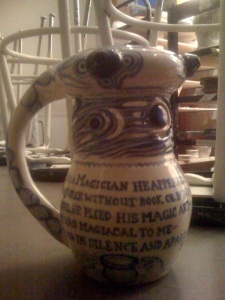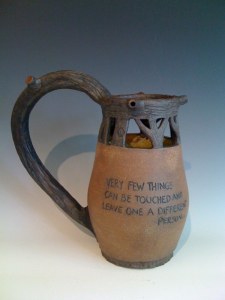Before our Saturday Open Studio session this weekend, I snapped a couple of pictures of Liam’s puzzle jug. One of those shots is the featured image on this post. It’s deliberately not a good shot. The piece will be “unveiled” at our student art show, later this week. You’ll have to come see it there.
Puzzle jugs are really hard to make. First, you have to make a vessel of a certain shape, with a rim thick enough to split and close in a hollow tube at the top. Then you have to create a hollow donut for a handle, and attach it so that there is a hollow channel that extends from the rim, through the handle, and all the way down to the bottom of the vessel. While keeping that channel open, you have to add three spouts to the top rim. You’re not done yet; you still have to carve out designs from the middle of the vessel without cracking or breaking it. And then you have to crank it first to 1800+ degrees, then to 2200+ degrees, without glaze, shrinkage, or pressure sealing up any of the hollow spaces.
Sounds complicated, right? It is.
The story of puzzle jugs in our studio is that a few years ago, one of our history teachers shared a story. He told one of my upper-level students – a very driven and talented young man who has since gone on to study craft in college – that the puzzle jug was the piece that an apprentice potter in 18th century Holland would have to make in order to leave his apprenticeship and branch out on his own.
Now, I haven’t been able to independently verify that story. But the effect of its telling was that within a day, the student and I were both attempting to make puzzle jugs. One thing this young man and I have in common is a competitive streak.
He got his on the first try. I wish I had a better photo, but it looked something like the picture below. I think I deleted the better shot, because he didn’t include it in his portfolio – the history teacher glazed it, so it wasn’t entirely his work. But he nailed it in terms of form and function.
As for me, it took me seven tries to make my jug. Seven. My student eventually coached me through part of the process. And, once all was fired, glazed, and fired again, a tiny leak emerged in the bottom of the handle attachment. I tried to seal it with epoxy, and it sort of worked, but the toxic glue left drinking from the vessel out of the question. I guess it looks alright, but next to the delicate porcelain piece my student created, it felt clunky and awkward.
He was ready to leave his “apprenticeship.” And he did, and he’s going farther with craft than I ever will.
I tell that story in my classes now, because I like to observe their reactions when I share with them that one of my students passed me up in ability. And I throw down a gauntlet with the story – a functional puzzle jug, made outside and above class requirements, equals an A+. (I typically don’t give any A+ grades, for reasons that I’ll explore in another post someday.)
So, you can imagine my mild surprise and amusement when Liam – a first-semester freshman – announced that he was going to make a puzzle jug before he finished Ceramics I. “Don’t be too disappointed, kid… but that doesn’t happen very often,” I remarked, as he handled and analyzed a puzzle jug in the studio made by a previous upper-level student – one that didn’t quite work.
It took Liam three or four tries before he realized he wasn’t going to be able to throw the form without a lot more practice on the wheel. So he decided to handbuild it, out of coils, pinch, and slab. His determination early in the course turned into a habit. He joined my homeroom, and started regularly being the last student to leave the studio at the end of the day. It was thick and heavy – but at the time of the bisque, his jug seemed to be functional. In the first firing, the bottom blew out… and so, he threw a new disc for the bottom, and sealed it to the base with glaze.
Over winter break, I pulled it out of the glaze firing, took it directly to the sink, filled it with water, re-solved the “puzzle,” and took a big, functional drink. And then snorted the water out through my nose with laughter – the darn thing worked perfectly.
If there’s one trait that unifies the students I’ve taught who have gone on to success in the arts, it’s this drive to push against the limits presented to them. During my first few years of teaching, this pushback sometimes upset my ego. Now I consider it almost textbook potential for excellence in the arts, when I observe that I don’t think a student will be able to do something… and this fuels his drive to do it.
In a recent blog post, Seth Godin eloquently notes:
At some level, “this might not work” is at the heart of all important projects, of everything new and worth doing. And it can paralyze us into inaction, into watering down our art and into failing to ship….. “This might not work” is either a curse, something that you labor under, or it’s a blessing, a chance to fly and do work you never thought possible.
I think it’s really something special to be able to look past “this might not work,” and see the potential of great things if it does. “Great” can start with a puzzle jug, or an unconventional solution to a problem, or a brave conversation. It’s impossible to evaluate on a scantron, though. Who knows the road that lies ahead for Liam? He has many abilities and many interests to explore. In this case, though, his determination and unwillingness to settle for externally-set limits led him to success. I hope that lesson is one that transfers beyond the studio.
I know I have a lot to learn from it.









Very cool story. I’d love to handle a puzzle jug to get a better idea of what it is.
Its funny that motivation is somewhat counter intuitive. If you encouraged the students and said “you can do it!” they probably wouldn’t have tried, but by saying that they might not be able to they wanted to give it a go. Its as if discouragement is really the best encouragement sometimes.